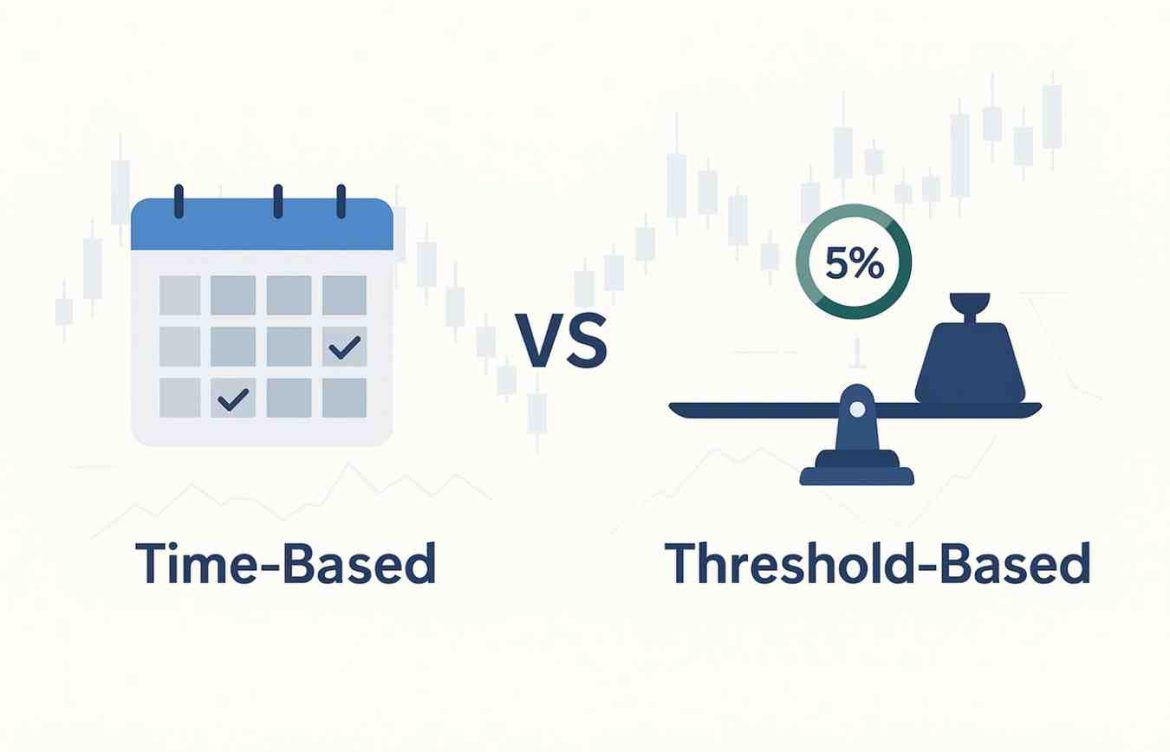
Time-Based vs. Threshold-Based Rebalancing: Which Strategy is Right for You?
Time-Based vs. Threshold-Based Rebalancing: Which Strategy is Right for You?
Portfolio rebalancing is an essential part of long-term investing, ensuring that your investments stay aligned with your goals, risk tolerance, and time horizon. Over time, market fluctuations can tilt your portfolio away from its intended allocation. For instance, equity exposure may grow larger during a bull run, increasing your risk beyond what you originally intended. This is where rebalancing strategies come in, and among the widely used approaches are time-based portfolio rebalancing strategy and threshold-based rebalancing in investing.
Understanding these methods and their practical implications can help investors make informed choices.
Why Portfolio Rebalancing Matters
Investors build portfolios with specific allocations—say, 60% equities and 40% fixed income—based on their financial objectives. Market movements can change these allocations, potentially exposing investors to unwanted risks. Regular rebalancing helps restore balance, maintain discipline, and reduce emotional decision-making. The benefits of rebalancing investment portfolios also include:
- Keeping risk exposure consistent with original investment goals.
- Helping investors capture gains from outperforming assets while reallocating to underperforming ones.
- Encouraging disciplined investing, which is often more effective than timing the market.
Time-Based Portfolio Rebalancing Strategy
A time-based portfolio rebalancing strategy involves adjusting portfolio allocations at fixed intervals, such as quarterly, semi-annually, or annually. Investors commit to rebalancing at these pre-determined times, regardless of market conditions.
Advantages:
- Simple to implement and track.
- Removes the influence of market noise, focusing only on calendar-driven discipline.
- Works well for long-term investors who prefer a systematic approach.
Considerations:
- May result in unnecessary rebalancing when market deviations are small.
- Could miss opportunities to lock in gains or reduce risks when sudden market shifts occur between scheduled dates.
Threshold-Based Rebalancing in Investing
In contrast, threshold-based rebalancing in investing adjusts the portfolio only when asset allocations drift beyond a set percentage from the target. For example, if equities drift more than 5% above or below their target allocation, a rebalance is triggered.
Advantages:
- More responsive to market conditions compared to time-based strategies.
- Helps minimize trading costs by avoiding unnecessary rebalancing.
- Keeps the portfolio aligned more closely with the intended risk profile.
Considerations:
- Requires ongoing monitoring of portfolio weights.
- Frequent rebalancing during volatile markets may lead to higher transaction costs.
- Investors must carefully choose the right threshold to balance efficiency and cost.
Portfolio Rebalancing Methods Comparison
When making a portfolio rebalancing methods comparison, investors need to weigh simplicity, responsiveness, and costs.
- Time-Based Strategy is easier to follow and suits investors seeking minimal monitoring. It works best for individuals who prefer a disciplined, calendar-driven approach.
- Threshold-Based Strategy provides better alignment with market shifts and may be more cost-efficient for investors who track their portfolios closely. However, it demands more involvement and decision-making.
Choosing the Right Rebalancing Strategy for Investors
The question of choosing the right rebalancing strategy for investors depends on individual preferences, portfolio size, and available time.
- For passive investors: Time-based rebalancing is often practical since it avoids the need for constant portfolio tracking.
- For active investors: Threshold-based rebalancing may be more suitable, particularly for those comfortable with monitoring portfolios and acting on triggers.
- For Indian investors: Transaction costs, taxation, and the frequency of trading are key factors. Equity mutual funds and ETFs often allow systematic transfers or switches that can simplify either strategy.
Blending Both Approaches
Some investors adopt a hybrid approach, rebalancing at set intervals but only if thresholds are breached. For example, rebalancing every six months but acting earlier if allocations move outside a 5% band. This approach combines the discipline of time-based rebalancing with the responsiveness of threshold-based triggers.
Conclusion
Both strategies—time-based and threshold-based—have their place in portfolio management. The decision lies in aligning the method with your personal investing style, monitoring capacity, and long-term objectives. Understanding the benefits of rebalancing investment portfolios and assessing a suitable approach can help Indian investors maintain balance, manage risks, and stay on track toward financial goals.
Whether you prefer the simplicity of a calendar-driven process or the precision of threshold-based triggers, disciplined rebalancing remains a cornerstone of sound investing.
At Goodwill Wealth Management, we understand that experienced as well as new investors demand more than just the basics. That’s why we created Giga Pro, a mobile trading app designed to fuel your investment journey. As a leading stock broker in India, we empower you with the tools and resources you need to succeed. Download the app today to start your trading journey on your Android device: (Download GigaPro Mobile App) or on your Apple device: (Download GigaPro Mobile App).
Related Blogs:
What is Sector Rotation and How Does it Work?
How to Implement Diversification for a Profitable Portfolio
Build a Stronger Investment Portfolio Through Diversification
Diversification Strategies: Combining Commodities and Equities
Diversification Strategies: Why Spreading Your Risk Matters
How to Use Sector Rotation to Diversify Your Portfolio
Disclaimer: This blog post is intended for informational purposes only and should not be considered financial advice. The financial data presented is subject to change over time, and the securities mentioned are examples only and do not constitute investment recommendations. Always conduct thorough research and consult with a qualified financial advisor before making any investment decisions.
